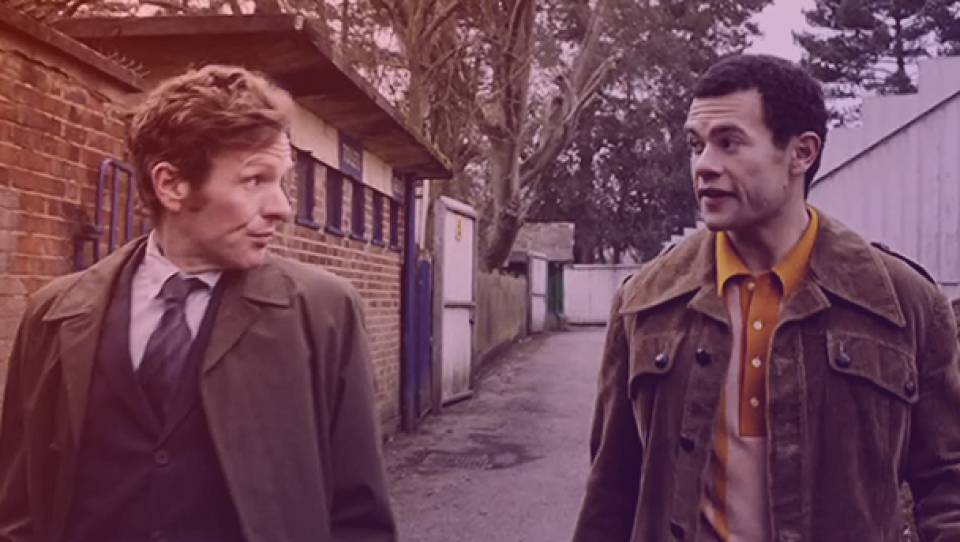Throughout the years, everyone’s favorite failed academic turned detective Endeavour Morse has had several cases that touch on race. “Striker,” the Endeavour Season 8 premiere episode brings to the attention of US viewers what life was like at the intersection of race and political/national identity in Northern Ireland in the 1970s. The case has many twists and turns, resulting in racism surprisingly not being the main motivation for the crime, but Endeavour has consistently used the mysteries of the week to highlight Black history that other dramas ignore.
Jack Swift is first introduced as a biracial football star from Northern Ireland playing for a British team who receives a death threat if he plays in an upcoming game. It’s very obvious his critics are quick to sink into racist rhetoric such as “the tar brush” to undermine his status as a revered soccer star. The threat is more than just an attempt to prop up his fan and now rival on the field Martinelli. As a Caribbean-American, I immediately detected unspoken jealousy that a Black man achieved something white players failed to do in the way some of the other characters interacted with Swift.
The show within a show “This Is Your Life” presents Swift with the chance to stroll down memory lane. As we see Swift’s old teammates and people from his hometown, there are some questions that this montage doesn’t answer: did Swift grow up with any Black friends or relatives? Would his level of acceptance have been the same if he was darker skinned, or if he wasn’t winning every football match? The scenes where Morse kept watch in Swift’s house showed that life was lonely at the top, but it’s also clear that Swift’s feelings were likely compounded by overt and covert racism. It doesn’t help that the only other Black person we saw in this episode, Mrs. Fenner, also appears exoticized in her position in the fashion industry.
Jack Swift is loosely based on the famous 1970s Northern Irish player George Best . However, the real history of Black and other racial minorities in Northern Ireland in 1971 contrasts even more starkly to the fictionalized details of Jack Swift’s life. First of all, the UK civil rights legislation passed in the UK in 1965 and 1968 excluded Northern Ireland according to historian and professor Jack Crangle. Legislation banning non-Northern Ireland residents from being employed also had the unintended consequences of banning Commonwealth migrants from finding jobs. The lack of government oversight meant hate crimes against racial minorities, housing discrimination, and a whole host of other racist actions left people like Swift with no legal recourse. Crangle also quotes Northern Irish politicians claiming the region did not have a “colour problem” to derail civil rights laws. Other politicians claimed immigration was more of a problem than race.
“Striker” left just enough clues for fans to find the historical context for themselves. This episode is far from the only one where the case intersects with race. Over the seasons, Endeavour has shown a fantastic ability to reckon with Black British History in the 1960s. I first truly fell in love with the show when I watched Season 2 for the first time in 2017 when Monica Hicks was introduced. Monica (and possibly her parents) were part of the Windrush Generation of Caribbean immigrants to the UK, commemorated each year on June 22nd. Many Black women worked as NHS nurses. Unfortunately, far too many fans in the UK reacted terribly to the implications of Morse dating Monica. Instead of seeing Monica as the beginning of Baby Morse’s road away from youthful idealism, people saw the plot as a severe deviation from Inspector Morse canon. One can argue that racists were hiding behind canon purism to express their displeasure. Monica’s episodes prove early on that Endeavour’s scripts involve a great deal of research before the cameras roll.
The season 5 episode “Colours” shows the rise of the fascist movement among vulnerable young working-class whites. This episode is technically the flip side of Ridley Road, but also expands on the theme. Thursday decries the suspect for running with a “racialist” crowd which is a clear reflection of how his military service influenced his views of the fascist movement.
Season 5’s arc was a rare example of Endeavour casting a Black actor as a suspect guilty of offenses. Cromwell Ames, who took over Oxford’s main mafia racket, was also part of the Windrush Generation. Although the arc doesn’t go into much detail about his life, it is likely that he pursued illegal means of making money because discrimination prevented more legitimate options. The script is careful to separate Ames’ Mafia activity from his Blackness, a fine line to take. “Cartouche,” another Season 5 episode, also takes the time to critique colonialism but through the lens of what Edward Said defines as Orientalism . Today, stolen artifacts are slowly being repatriated .
The Season 6 finale “Deguello” does turn Morse into a white savior figure but it also highlights the 1960’s version of Grenfell: the Ronan Point tower collapse . Shoddy construction of the “streets in the sky” was influenced by systemic racism as these projects targeted working-class Black British residents who were denied housing elsewhere.
I wish I could ask screenwriter Russ Lewis about the finer points of his process but I believe Endeavour’s ability to draw out deeper narratives about race in the UK starts with deep dives into the Oxford police blotter beyond Colin Dexters’ novels. Hopefully, the final season will have one final chance to recenter previously undiscussed history.





